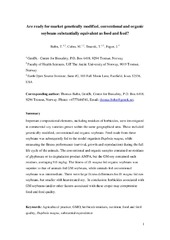Are ready for Market Genetically Modified, Conventional and Organic Soybeans Substantially Equivalent as Food and Feed?
Sammendrag
Important compositional elements, including residues of herbicides, were investigated in commercial soy varieties grown within the same geographical area. These included genetically modified, conventional and organic soybeans. Feed made from these soybeans was subsequently fed to the model organism Daphnia magna, while measuring the fitness performance (survival, growth and reproduction) during the full life cycle of the animals. The conventional and organic samples contained no residues of glyphosate or its degradation product AMPA, but the GM-soy contained such residues, averaging 9.0 mg/kg. The fitness of D. magna fed organic soybeans was superior to that of animals fed GM soybeans, while animals fed conventional soybeans was intermediate. There were large fitness differences for D. magna fed raw soybeans, but smaller with heat-treated soy. In conclusion: herbicides associated with GM soybeans (and/or other factors associated with these crops) may compromise food and feed quality.
Beskrivelse
Accepted manuscript version. License in accordance with the publisher's policy - CC-BY-NC-ND.


 English
English norsk
norsk